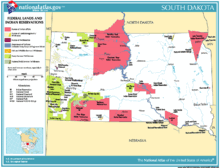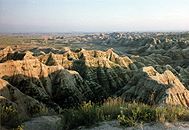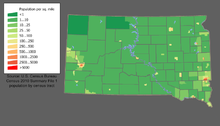South Dakota
| South Dakota | |||||
|---|---|---|---|---|---|
| |||||
| List of states | |||||
| Capital: | Pierre | ||||
| State motto: | Under God the people rule / Under God the people rule | ||||
| Official language : | English | ||||
| Surface: | 199,731 km² | ||||
| Residents: | 814,180 (2010 census) (4 U / km²) | ||||
| Member since: | November 2, 1889 | ||||
| Time zone: | Mountain: UTC − 7 / −6 Central: UTC − 6 / −5 |
||||
| The highest point: | 2,207 m ( Black Elk Peak ) | ||||
| Average Height: | 670 m | ||||
| Deepest point: | 294 m Big Stone Lake | ||||
| Governor : | Kristi Noem ( R ) | ||||
| Post / Office / ISO | SD / / US-SD | ||||
| Map of South Dakota | |||||
| Geographical map of South Dakota | |||||
South Dakota ( English pronunciation [ ˌsaʊ̯θ dəkʰoʊ̯ɾə ] , German South Dakota ) is one of the northwestern plains - states of the United States . It covers 199,731 km². The Black Hills are to the west , the Badlands to the east and the Coteau des Prairies to the east of the state . The largest city is Sioux Falls , the capital is Pierre . South Dakota is home to several Indian reservations , particularly the Lakota . The state has the third highest percentage of Indians in the United States after Alaska and New Mexico .
The name Dakota is derived from the Indian ethnic group of the Dakota who lived in this area before the submission by the whites . South Dakota's nickname is The Mount Rushmore State .
geography
Neighbore states
South Dakota is bordered by North Dakota to the north, Minnesota and Iowa to the east, Nebraska to the south, and Wyoming and Montana to the west .
structure
The state is divided into 66 counties .
history
The Dakota Territory was a territory of the United States. In 1889 it was divided into a northern and a southern half. These areas, North Dakota and South Dakota, were added to the United States as the 39th and 40th states.
On December 29, 1890, the Seventh US Cavalry massacred over 300 men, women and children of the Minneconjou - Lakota - Sioux - Indians under Chief Big Foot at Wounded Knee . This massacre broke the last resistance of the Indians against the whites. On February 27, 1973, members of the American Indian Movement, together with sympathizers from the Pine Ridge Reservation, occupied the village of Wounded Knee and proclaimed the independent Oglala nation.
From 1944, dams were built along the Missouri to protect the lower lying areas from flooding. To do this, several tribes were forcibly relocated and their land disappeared under the water of reservoirs such as Big Bend and Oahe. In 2010, those affected demanded compensation for the destruction of their land. Of the seven affected tribes, the Standing Rock Sioux, the Cheyenne River Sioux, the Crow Creek Sioux, the Lower Brule Sioux and the Yankton Sioux live in South Dakota. The Crow Creek Sioux reservation was inundated by the Big Bend Dam, which was built in 1959-63. Their facilities had to be moved to Pierre. The tribes are complaining not only for compensation for the loss of their land and their real estate, but also for participation in the use, for example through tourism. Crow Creek received $ 27.5 million and Lower Brulé Sioux received $ 39.3 million. The Cheyenne River Sioux, on the other hand, received 290 million. In 2004 the lower compensated tribes failed in the Senate with further demands.
population
Indians

The tribes resident in South Dakota belong to the large Sioux language family and are assigned to the Lakota , Dakota or Nakota . In some counties they make up 20 percent of the population; B. in West River. There are seven major Indian reservations in the state that grew out of portions of the large Sioux Reservation from the West River , Standing Rock Reservation , Cheyenne River Reservation , Pine Ridge Reservation , Rosebud Indian Reservation , Yankton Reservation , Crow Creek Reservation, and Lower Brule Reservation . This large reservation was assigned to the once resident Sioux by the US government. Another large reservation is the Lake Traverse Indian Reservation in the northeast of the state . There are also a few smaller ones like Flandreau Indian Reservation . The Indian tribes also own large areas outside of the reservations called Off reservation trust land . South Dakota has the third highest percentage of Native Americans in the United States after Alaska and New Mexico.
Population and ethnic origin
South Dakota has 814,180 inhabitants (as of: Census 2010), of which 87.2% are white, 0.7% black and African-American, 8.6% Indians, 0.9% Asians. 2.0% Hispanics.
Population development
|
||||||||||||||||||||||||||||||||||||||||||||||||||||||||||||||||||||||||||||
About half of South Dakota's residents live in the countryside, with the population concentrated in the eastern part of the state.
Religions
Lutheran churches form the largest religious group with a total of 30.3 percent, followed by Catholics (25.7 percent) and followers of Methodist churches (10.5 percent), Baptists (6.1 percent) and Presbyterians (2.9 percent ). The Lutheran church with the largest number of members in South Dakota is the Evangelical Lutheran Church in America with 181,434 members and by far the most important Methodist church is the United Methodist Church with 37,280 followers.
politics

As a federal state of the United States , South Dakota is a partially sovereign member state with its own institutions at the state level on the one hand and participation in the institutions of the entire state on the other.
The population of South Dakota is considered to be conservative, so the Republicans dominate .
National level
In South Dakota there is a division of powers between the legislature , the executive and the judiciary . The governor has been the Republican Kristi Noem since 2019 .
The state legislature is divided into a House of Representatives with 70 and a Senate with 35 members. Because of the majority vote, South Dakota is divided into 35 Senate and 70 House electoral districts. The Republican Party has a majority in both chambers (as of 2019).
The Supreme Court is the highest court in the state. It consists of a chief judge and four other judges.
Governors
Federal level
Like every state, South Dakota has two US Senators and - due to its low population - only one member of the US House of Representatives . South Dakota has been represented in the Senate since 2015 by Republicans Mike Rounds and John Thune and in the House of Representatives since 2011 by Republican Kristi Noem . In presidential elections, the state has three electors.
As in North Dakota , the neighbor to the north, the prevailing combination of social conservatism and economic dependence on legislative grants for agriculture leads to a split in political loyalties: while in elections for the presidency since 1964 only Republicans have left South Dakota as the winners Democrats were also more often elected to Congress; the leader of the Democrats in the Senate until 2004, Tom Daschle , comes from South Dakota. Even George McGovern , the 1972 one on the end of the Vietnam War clearly directed campaign against Richard Nixon lost, came from that State.
congress
Biggest cities

education
There are six universities in South Dakota , South Dakota State University in Brookings , University of South Dakota in Vermillion , Northern State University in Aberdeen , South Dakota School of Mines and Technology in Rapid City , Black Hills State University in Spearfish and Dakota State University in Madison . There are also several private universities and technical universities.
Culture and sights
Parks
| National park | location | view |
|---|---|---|
Badlands National Park
Commons : Badlands National Park - Pictures
|

|
|
Wind Cave National Park
Commons : Wind Cave National Park - Pictures
|

|
Natural monuments
- Jewel Cave National Monument
- Mount Rushmore National Memorial
- Crazy Horse Memorial
- Black Hills with the Black Hills Caves
- Historic downtown Deadwood
- State parks
Economy and Infrastructure
The real gross domestic product per capita GDP - the most important indicator of prosperity - was USD 55,623 in 2016 (national average of the 50 US states: USD 57,118; national ranking: 22). The unemployment rate was 3.5% in November 2017 (national average: 4.1%). South Dakota is therefore significantly poorer than neighboring North Dakota.
The main branch of the economy is agriculture (cereal cultivation, cattle farming). Gold mining in the Black Hills is also important .
See also
Individual evidence
- ^ Density Using Land Area
- ↑ States Ranked by American Indian and Alaska Native Population, July 1, 1999. US Census Bureau, Washington, DC, August 30, 2000, accessed January 12, 2017 .
- ^ Dam compensation for tribes proposed, in ArgusLeader , 23 August 2010
- ↑ factfinder.census.gov
- ^ US Census Bureau _ Census of Population and Housing . Retrieved February 28, 2011
- ↑ Extract from Census.gov . Retrieved February 28, 2011
- ↑ Excerpt from factfinder.census.gov.Retrieved February 28, 2011
- ^ The Association of Religion Data Archives | Maps & Reports
- ^ US Department of Commerce, BEA, Bureau of Economic Analysis: Bureau of Economic Analysis. Retrieved August 27, 2017 (American English).
- ^ Unemployment Rates for States. Retrieved January 8, 2018 .
Web links
- Official website of the state of South Dakota. Accessed April 27, 2019 .
- South Dakota Office of Tourism - Official Tourist Information
Coordinates: 44 ° 29 ′ N , 100 ° 15 ′ W








